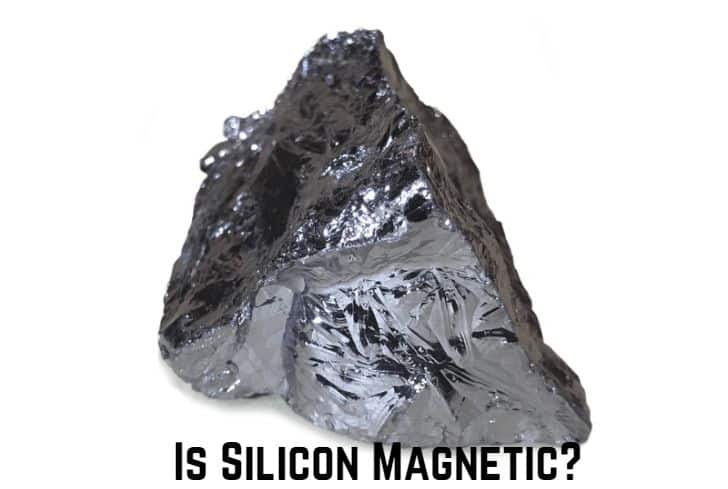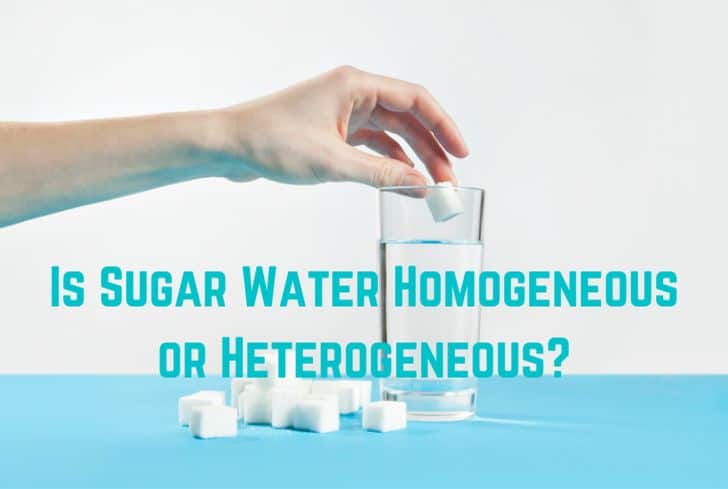Is Silicon Magnetic? (We Have Answer)

Most people who work in mining, are stone cutters or live in sandy areas have heard about silicosis. It is a lung condition brought on by breathing in silicon compounds. Yet silicon also has advantages. Among many other industrial uses, manufacturing steel is one of them. Most people, however, are curious about the magnetic properties of silicon. So, is silicon magnetic?
We tell you if silicon conducts electricity, is malleable, magnetic, or non-magnetic. Also, you will discover more about silicon carbide, whether it is magnetic, and if silicon chips are recyclable. We’ll let you know if the silicon dissolves in water.
Read: Does Granite Conduct Electricity? (No. It Doesn’t)
Is Silicon Magnetic or Non-magnetic?
Silicon’s fragile crystal-like structure stops it from being magnetic. Each component atom lacks a permanent magnetic dipole, making the creation of new atoms impossible. Every substance must have a permanent magnetic dipole among its atoms to be magnetic. The magnetic dipole moment measures a material’s ability to align with a magnetic field.
A magnetic moment exists in everything magnetic. The moment measures the magnetic field’s strength. Magnetism is a property of materials with unpaired electrons. Silicon is regarded as diamagnetic because it lacks any unpaired electrons. It has paired electrons throughout. Diamagnetic denotes the lack of magnetic sensitivity.
The electron spins should occur in opposite directions since no two electrons may simultaneously be in the same quantum state. The electrons’ magnetic fields cancel out as a result. The atom cannot be attracted to a magnetic field without a net magnetic moment.
The number of electrons in the silicon atom is 14. The 14 electrons move around the nucleus in closed stationary orbits.
Electronic configuration of silicon(Si) = 1s22s22p63s23p2
Is Silicon Carbide Magnetic?
Silicon carbide is also diamagnetic. We’ve already revealed the reason silicon is not magnetic. Due to the presence of two unpaired electrons in a 2p orbital, carbon is diamagnetic. Metallic bonding involves pairing together these unpaired electrons. As the electrons in the 2p orbital fill up, the angular and spin momentum cancels, leaving no magnetic moments.
Pure silicon and carbon are combined to form silicon carbide, also known as carborundum. It creates a crystalline structure with covalent bonds between the crystals as it crystallizes. A silicon atom is covalently linked to four carbon atoms to form silicon carbide.
Let’s look at the characteristics that make carbon diamagnetic as one of the compounds that make up silicon carbide:
- Carbon has a magnetic moment of 0.
- C-metal transitions from a strong magnetic field to one that is weaker.
- The C-electron metal is all paired.
- The magnetic field repels carbon, which produces this effect.
Is Silicon Malleable?
Silicon is not malleable. It is brittle and delicate even though it is solid at room temperature. Silicon is a metalloid, which means it possesses metallic and nonmetallic qualities. Metalloids display traits from both categories. They have a physical appearance similar to metals, but chemically they are non-metals. It is possible to beat malleable materials into thin sheets.
Since they are malleable, metals can be moulded or pounded into various forms without breaking. Because of the regular arrangement of the atoms of metals, particles can readily slip past one another. Non-metals are not very bendable and will crack when rolled or pounded. Their atoms don’t have a regular pattern.
There are several metalloids, some of which are malleable and others which are not. One of the metalloids that are not malleable is silicon.
Does Silicon Conduct Electricity?
Silicon can conduct electricity better than non-metals but not as well as metals. It’s a semiconductor. Because their electrons are delocalized, metals are effective electrical conductors. The outer shell of silicon contains four electrons. Due to their mobility, electrons carry an electric charge. Silicon is a non-metal, so it conducts electricity more effectively as the temperature rises.
On the other hand, as the temperature rises, metals lose some of their capacity to conduct electricity. Silicon is common in many electrical devices because of its limited capacity to conduct electricity. Silicon exists in rectifiers, photovoltaic cells, personal computers, smartphones, and photovoltaic circuitry.
A substance you can turn on and off at a whim is necessary for a computer resistor. For this, you’ll require a material that is a semiconductor. Although it is not the only semiconductor manufacturers can use, silicon is the most extensively used. It can also be produced in large quantities and is simple to work with.
Can Silicon Chips Be Recycled?
Silicon chips are not recyclable. Pure silicon is required to create the chips. The chips have already been doped with additional components and metal conductors to develop transistors. As a result, silicon chips are no longer suitable for producing new chips because they are no longer pure. Doping a chip entails adding additional, difficult-to-remove elements like boron, arsenic, and phosphorus.
Some have proposed that the chips can be recycled and used to create solar panels. To build the panels, though, you’ll need a lot of silicon. Removing individual chips from a mobile phone, laptop, and other devices will now be challenging unless it’s in a factory setting where you can get the rejected chips to recycle.
However, given how inexpensive silicon is, recycling silicon chips is hardly worth the cost. Sand, commonly called silicon dioxide in powder form, is widespread. Building the infrastructure necessary to recycle similarly inexpensive silicon chips would not be profitable. It is only worthwhile once there are more valuable components in silicon chips that people can recycle.
Read: Does Potassium Conduct Electricity? (Answered)
Is Silicon Soluble in Water?
Silicon is not soluble in water. The massive covalent structure prevents silicon from dissolving in water. A strong oxide layer serves as a water barrier around the silicon atom. As a result, water and silicon cannot mix. A lot of energy is needed to break the solid covalent bond. Because silicon is non-polar and has stronger internal bonds than those with water, it cannot dissolve in water.
Water does not have a solid attraction to silicon atoms. The only substances that dissolve readily in water are polar ones. Due to its higher density than water, silicon is not soluble in water. Silicon repels water. Hence silicon is regarded as hydrophobic.
Non-polar molecules found in hydrophobic materials resist water bodies. Nevertheless, non-polar molecules usually attract non-polar liquids and other neutral molecules.
Water and silicon mix to create two separate layers. Since silicon is non-polar, its structure is symmetrical. Because the forces pulling on the structure are balanced, it is stable and resists dissolving in water. Polar substances, however, have asymmetrical structures. Due to their unbalanced nature, these structures are fragile and easily dissolve in water.
Silicon cannot dissolve in water, making it ideal for creating electronic gadgets. It is unaffected by water exposure and can resist it.
Frequently Asked Questions
What is the difference between silicon and silicone?
In contrast to silicone, a polymer of silicon, oxygen, hydrogen, and carbon, silicon is a chemical element that occurs naturally. The crystalline solid of raw silicon is challenging to work with, brittle, and has a metallic luster. On the other hand, silicone is a synthetic material that is typically liquid or a flexible rubber similar to plastic.
Silicon is common in various industrial products, including electronics and the construction materials concrete, glass, and bricks. Manufacturers prefer silicon for producing implants, bandages, and catheters in the medical industry. In addition, you can find silicon in various personal care products, cookware, sealants, electronics, and automotive components lubricants.
Is silicon the same as glass?
No, but there is silicon glass, a premium glass made exclusively from silica. The main ingredient is high-quality mountain crystals. You can also fuse fine quartz sand. Unfortunately, this method is made imperfect by the entrapment of microscopic air bubbles.
However, the highest quality silicon glass comprises synthetic silica (SiCl4). You’ll have to treat the glass with an oxygen-hydrogen flame. The product is free from bubbles.
Why are chips made of silicon?
The main reason is that it is an easily accessible semiconductor in nature. After oxygen, silicon is the second most common element on earth. Due to its composition, it mixes readily with substances like boron and phosphorus.
The material used to make the chips is silicon dioxide, sometimes known as silica sand. A large cylinder-shaped piece of sand is cast after being heated. After that, the cylinder is cut into tiny wafers. There are two kinds of chips: logic chips, which use information processing to finish tasks. And the information-storing memory chips.
Conclusion
Silicon is non-magnetic, and so is silicon carbide. The two unpaired electrons at the end of the outer orbital fill up due to metallic bonding. None of the electrons is free; hence, these compounds become diamagnetic. Silicon is also one of the few metalloids that are not malleable.
Because silicon is a metalloid, it carries the characteristics of metals and non-metals. It can conduct electricity better than non-metals but not as well as metals. Silicon is thus referred to as a semiconductor and has become popular in making electrical parts such as chips.
The presence of silicon naturally removes the need to recycle silicon chips. Silicon does not dissolve in water due to its non-polar nature.






